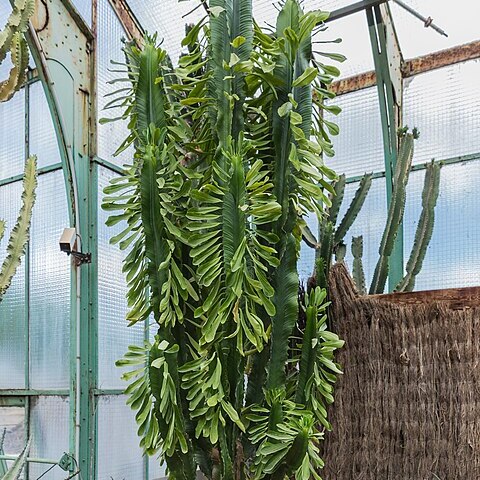Spine shields rounded, to 5 mm in diameter, eventually extended to 5 mm above the spines to enclose the flowering eye; spines stout, 1–3 mm long; prickles absent or rudimentary; spine shields and spines becoming corky and disintegrating.
Cymes 1 or 2–3 in a horizontal line, or occasionally 4 crowded together, 1-forked lateral cyathia vertically arranged; peduncles and cyme branches stout, 3–4 mm long; bracts rounded, 4 × 7 mm.
Cyathia c. 4 × 7 mm, with cup-shaped involucres; glands transversely elliptic, c. 2 × 4 mm, margin undulate, not quite touching, yellow; lobes c. 2 × 3.5 mm, transversely elliptic.
Capsule to 12 × 16 mm, subglobose, fleshy, red, hardening before dehiscence to become obtusely 3-lobed with woody walls 2–3 mm thick; pedicel stout, 3 mm long.
Female flower: perianth irregularly divided into 5–12 lanceolate toothed lobes to 6 mm long; styles 3.5 mm long, joined at the base, apices thickened, bifid.
A tree. It grows 30 m high. The trunk has slight buttresses at the base. The crown is small. The leaves are small. They are near the end of stems.
Leaves persistent on young growth, to 15 × 6 cm, obovate, fleshy, midrib keeled on lower surface, base tapering to a petiole c. 1 cm long.
Seeds 4.5 mm in diameter, subglobose, slightly laterally compressed, yellowish-brown, speckled, smooth.
Tree to 10(30) m high; trunk simple to c. 90 cm in diameter; bark rough greyish.
Male flowers: bracteoles spathulate, plumose; stamens 6 mm long.

